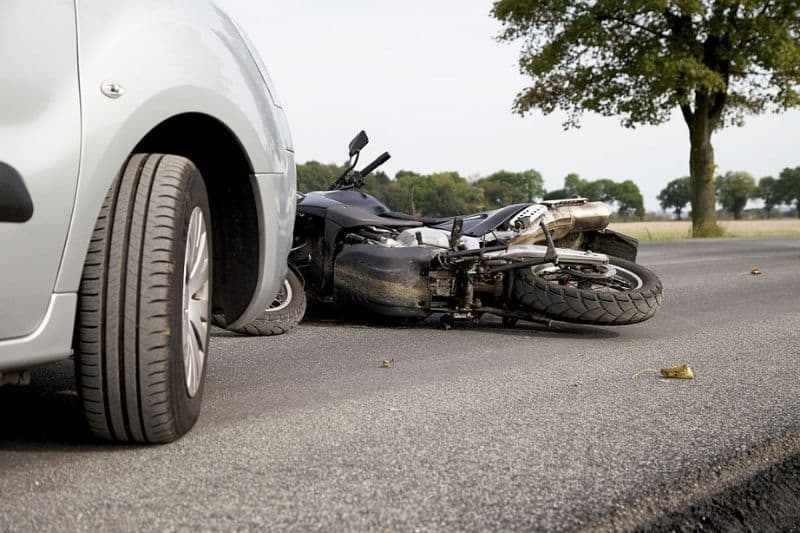Usually, one of the concerns new riders have is about their safety. Often their friends and relatives will tell them that riding a motorcycle means that they will invariably die. Nobody wants that to happen to their friends and family. But does riding a motorcycle automatically mean you will die?
This is why so many people will ask the question, “Will I die if I ride a motorcycle?” If you crash while riding a motorcycle, you are more likely to die compared to driving a car. However, just because you are riding a motorcycle does not mean you will automatically die. Good riding habits, wearing motorcycle gear, and exercising extra caution will reduce the odds of dying on a motorcycle.
Table of Contents
Over the years, motor vehicle safety has vastly improved. This also applies to motorcycles and motorcycle gear. However, how likely is it for somebody to die if they ride a motorcycle, and are motorcycles really that dangerous? Let’s take a look.

Are you more likely to die riding a motorcycle?
I am sure that if you are looking to buy a motorcycle, you have already been told numerous times that motorcycles are not worth it, and that you will just get injured or killed while riding it.
But let’s take a good look at what the official data suggests.
Keep in mind that the data is often calculated based on the number of vehicles registered or the miles traveled. So it does not tell you exactly what will be your odds of crashing or dying as there are a lot of factors involved in that. However, you will clearly see some correlations.
Motorcycle fatality rates
According to the National Highway Traffic Safety Administration, the fatality rates per 100,000 registered motorcycles have been between 54.87 to 73.48 in the years between 2004 and 2017.
The numbers will vary from year to year, but you can see some trends.
According to the data, 10 out of every 100,000 cars are involved in a fatal accident, while 61 out of every 100,000 motorcycles are involved in a fatal crash.
On average, this is about 6 times higher than the fatality rates for passenger car occupants for the same period.
In 2017 about 96% of the fatalities involved the rider, and about 6% were passengers.
Per miles traveled motorcyclists are 27 times more likely to be seriously hurt and killed compared to passenger car occupants and about 6 times more likely to get injured.
If we take a more detailed look, we will see that all motor vehicle crash-related deaths in the US between 2010 and 2018 are between 32,479 and 37,806.
Passenger vehicle occupant fatalities account for 63% to 69% of that number or between 21,131 to 23.957.
On the other hand, motorcyclist fatalities are between 4,518 to 5,337, or 13% to 15% of all fatalities on the road.
Undoubtedly motorcyclists have a higher chance to die when involved in a crash-related accident on the road.
- That being said, motorcycle fatalities were more common in urban areas as opposed to rural areas.
- A higher percentage of fatalities happen at locations that are not intersections. With the vast majority happening on non-interstate roads.
- The vast majority of fatalities occurred in clear or cloudy weather as opposed to rain or fog conditions.
- A higher percentage of fatalities happen during daylight, followed by the nighttime.
Motorcycle crash rates
Generally, motorcycles make up for about 3% of all registered motor vehicles and around 0.6% for all miles traveled by motor vehicles. This means that motorcycles, on average, represent a small portion of all motor vehicles on the road.
However, as we have seen so far, they represent up to 15% of all fatalities caused by road accidents.
So motorcyclists are definitely more likely to be involved in a more serious road accident. This means that, on average, motorcycle crashes result in more serious injuries that can be life-threatening.
However, are motorcyclists also more likely to be involved in a crash in the first place?
According to the data, in 2018, nearly 6.7 million passenger cars were involved in a traffic accident, which accounts for 55% of all crashes.
For the same period, the registered automobiles were about 111 million, making up about 40% of all registered motor vehicles.
In comparison, the number of registered on-road motorcycles in 2018 was around 8.2 million out of the 274 million registered vehicles in the US, which is about 3%. And about 109,000 motorcycles were involved in an accident for the same period, which equals about 0.90% of all crashes.
Now, if we compare those percentages, we can see that cars tend to get in an accident a little over twice as much as motorcycles.
Motorcycle injury rates
The data between 2004 and 2017 shows that the number of injured motorcyclists in a road accident varies between 76,000 and 104,000. If we take into account the fact that there have been between 5.7 to 8.7 million motorcycles registered throughout these years, this gives us injury rates between 965 and 1,443 per 100,000 registered motorcycles. When it comes to the miles traveled, we have between 430 and 835 injury rates for every 100 million miles traveled.
For example, in 2013, motorcyclists’ injury rates per 100,000 registered motorcycles were 1,052, while for passenger car occupants were 1,005.
Motorcyclist injury rates are, on average, slightly higher than the injury rates of passenger car occupants since motorcyclists are more likely to get injured than passenger car occupants.
What makes motorcycles dangerous?

Overall you can see that motorcyclists are at worse odds when it comes to road accidents.
Although they may not necessarily be at a higher risk of crashing compared to passenger cars, they are at a higher risk of sustaining more severe and even life-threatening injuries.
Which, when we think about it, is completely normal.
While driving a car, you are protected from all sides by the car. Although you may sustain some minor bruises and injuries, you need to be involved in a very serious crash to get seriously injured or killed in a car.
While being on a motorcycle, on the other hand, you are completely exposed.
The only thing protecting you is your motorcycle gear, which, as good as it may be, cannot really substitute for the protection offered by a car.
Because of the less protection, motorcycle accidents will often lead to more severe injuries like:
- Brain injuries
- Facial fractures
- Back and spinal cord injuries
- Thorax injuries
- Leg injuries
- Arm injuries
- Nerve damage
- Broken bones
- Internal organ damage
- Soft tissue injuries
- Crushing injuries
- Road rash
People can and do die from all kinds of different things. You need to realize that you are just at worse odds if an accident were to happen while riding your motorcycle and thus need to exercise extra caution.
The worst consequences are usually observed in crashes with other moving motor vehicles and stationary objects—especially if the rider has not been wearing proper motorcycle gear. On the other hand, a motorcycle crash does not automatically mean death or even a serious injury.
Just because you are riding a motorcycle does not mean you will inadvertently crash or die. Many motorcyclists have been riding their whole lives and have never been involved in a crash.
The biggest dangers come not from the motorcycle itself but from the other road users and the motorcyclist’s riding habits.
It is not a secret that motorcyclists will often ride too fast, ignore some basic safety rules and regulations, not pay attention, or not wear proper motorcycle gear, all of which will contribute to a higher risk of a road accident.
Common causes for motorcycle deaths
Speeding
In 2017 nearly 32% of the motorcyclists involved in a fatal crash were speeding.
This also involves people who will try to ride as if they are on the track, which often will result in some close calls. Motorcycles are fast, but that kind of riding should be reserved for the track days.
Driving under influence
Many people do all kinds of crazy stuff that will just put them at worse odds of surviving and avoiding accidents.
A lot of motorcyclists even drive under the influence. In 2017, for example, 28% of the motorcycle fatalities involved a motorcyclist driving under the influence. Also, 42% of the motorcycle riders killed in an accident during the night were alcohol-impaired.
In fact, in 2017, compared to all motor vehicle drivers involved in a crash, motorcyclists held the first spot when it came to alcohol impairment—27% for motorcyclists followed by 21% for car drivers, and 3% for large truck drivers.)
Getting distracted
The more experience you gain on the motorcycle, the more you will realize that you cannot afford to get too complacent. A good rule of thumb is to always ride with the assumption that everyone around you does not see or hear you. (No, a louder motorcycle will not help much.)
Don’t expect other people on the road to respect your right of way or even right to exist.
Always stay focused and aware of your surroundings and the other vehicles around you.
Be extremely careful and, if possible, always avoid riding tired as your ability to focus can be negatively impacted.
Lack of proper training
About 29% of all the motorcyclists involved in a fatal crash in 2017 did not have a valid motorcycle license.
Learning how to ride a motorcycle is a process that never ends. A lot of people may wonder if an MSF course is worth it, and some may even prefer to skip it. An MSF course can cover and teach you many things that otherwise you may not be aware of.
That being said, MSF courses are made for complete beginners only. There are also MSF courses that teach you some advanced riding techniques, so they are definitely worth looking into.
Many returning riders will pass an MSF course to brush up on their skills and get up to speed.
In addition to that, it is also worth understanding that people with less experience are more likely to get into an accident, so understanding your skill level and never riding beyond it is important.
See article: How long does it take to get good at riding a motorcycle?
Not wearing proper motorcycle gear
Not wearing the right gear means there may be nothing offering any acceptable levels of protection to your body. Of course, wearing motorcycle gear does not mean you cannot get seriously injured or killed, but it can improve your survival odds.
It has been estimated that for every 100 motorcyclists who did not wear a helmet and have died in a motorcycle accident, 37 of them would have survived if they all wore helmets.
In 2017 in states without helmet laws, about 57% of the motorcyclists killed in a motorcycle accident did not wear a helmet. In comparison, in states with universal helmet laws, that percentage was just 8%.
See article: What is the best color for a motorcycle helmet?
Not wearing a helmet or wearing a poorly fitted helmet is associated with higher injury and fatality rates.
See article: Why does my motorcycle helmet hurt my head?
FAQ’s
Can a motorcycle guarantee death, as some people suggest?
- No, riding a motorcycle does not automatically mean you will die. While motorcycle crashes have a higher fatality rate compared to car crashes, adopting good riding habits, wearing proper gear, and being cautious can significantly reduce the likelihood of dying on a motorcycle.
Are motorcycles more dangerous than cars?
- Motorcycle fatality rates are higher than those for cars. The fatality rate for motorcycles is around 6 times higher than for passenger cars. Motorcyclists are also more likely to be seriously injured in accidents compared to car occupants due to the limited protection motorcycles provide.
What factors contribute to motorcycle accidents and fatalities?
- Several factors contribute to motorcycle accidents and deaths, including speeding, driving under the influence of alcohol, getting distracted, lack of proper training, and not wearing proper gear. These factors increase the risks associated with riding a motorcycle and can lead to more severe injuries or fatalities in case of accidents.

Meet Simon, the 46-year-old aficionado behind YourMotoBro. With a lifelong passion ignited by motocross dreams and a Canadian Tire bicycle, Simon’s journey has been nothing short of extraordinary. From coaching underwater hockey to mastering muddy terrains, he’s an authority in thrill and adventure. Certified as an Off-Road Vehicle Excursion Guide and trained in Wilderness First Aid, Simon’s love for bikes is as diverse as his collection—from a robust BMW GSA R1200 to the memories of a Harley Davidson Night Train. By day a respected telephony consultant, by night a motorcycle maestro, Simon’s tales are a blend of expertise, resilience, and undying passion. ?️✨
